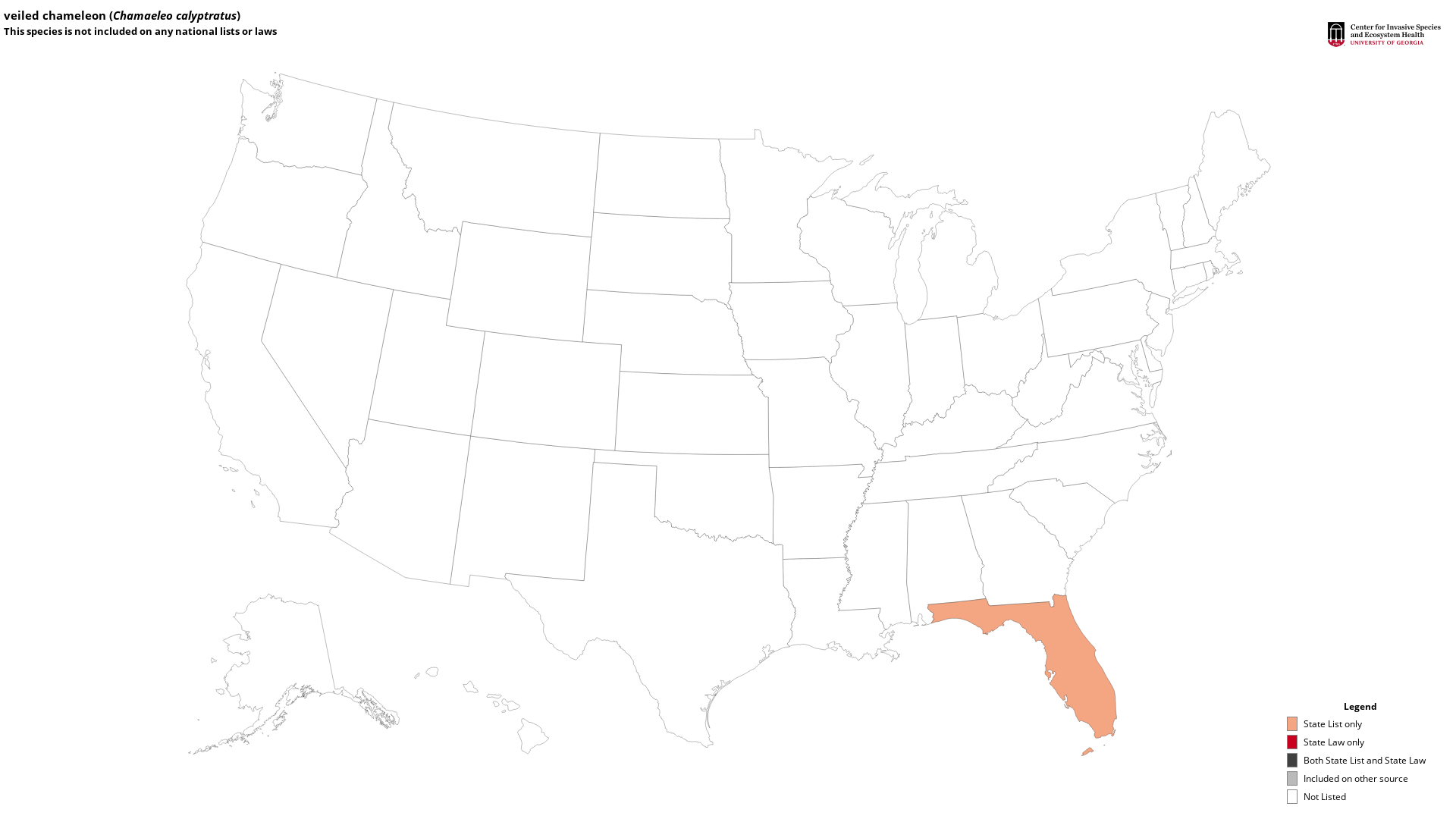veiled chameleon
(Chamaeleo calyptratus)
This species is Introduced in the United States
Origin
Chamaeleo calyptratus is native to the Arabian Peninsula. Veiled chameleons were introduced to the United States as escaped or released pets.
Life Cycle
Coloration is highly variable and can change quickly depending on environmental factors and the mood of the individual. Male C. calyptratus are approximately 24 in. (61 cm) in length with females half that size. The male has a small spur on the heel of the hindfoot, and the casque on the back of the head is taller than that of a female. Female C. calyptratus reach sexual maturity at 5-6 months with 30-60 eggs laid per clutch, in captivity. Chameleon eggs often go through a diapause (rest), period, and they typically take 6-8 months to hatch (Fife 1999).
Distribution
C. calyptratus are established with breeding populations in Florida and Hawaii.
Control Efforts
Veiled chameleon poses a threat to native species. Review your state's laws and regulations for the importation of exotic reptiles.
Fife, J. D. 1999. A kaleidoscope of coler. Reptiles Magazine 7(2):10-12, 14, 16-18, 20-23.
https://myfwc.com/wildlifehabitats/nonnatives/reptiles/iguanas-and-relatives/veiled-chameleon/
https://www.oregonzoo.org/discover/animals/veiled-chameleon
Chamaeleo calyptratus is native to the Arabian Peninsula. Veiled chameleons were introduced to the United States as escaped or released pets.
Life Cycle
Coloration is highly variable and can change quickly depending on environmental factors and the mood of the individual. Male C. calyptratus are approximately 24 in. (61 cm) in length with females half that size. The male has a small spur on the heel of the hindfoot, and the casque on the back of the head is taller than that of a female. Female C. calyptratus reach sexual maturity at 5-6 months with 30-60 eggs laid per clutch, in captivity. Chameleon eggs often go through a diapause (rest), period, and they typically take 6-8 months to hatch (Fife 1999).
Distribution
C. calyptratus are established with breeding populations in Florida and Hawaii.
Control Efforts
Veiled chameleon poses a threat to native species. Review your state's laws and regulations for the importation of exotic reptiles.
Fife, J. D. 1999. A kaleidoscope of coler. Reptiles Magazine 7(2):10-12, 14, 16-18, 20-23.
https://myfwc.com/wildlifehabitats/nonnatives/reptiles/iguanas-and-relatives/veiled-chameleon/
https://www.oregonzoo.org/discover/animals/veiled-chameleon
Resources
- Florida's Exotic Wildlife Species Detail - Florida Fish and Wildlife Conservation Commission
- Wikipedia - Wikimedia Foundation, Inc
- Animal Diversity Web - University of Michigan Museum of Zoology
- Stopping the Silent Invasion - Hawaii Invasive Species Partnership
- Reptiles and Amphibians Fact Sheets - Smithsonian National Zoological Park
Selected Images
Maps
EDDMapS Distribution - This map is incomplete and is based only on current site and county level reports made by experts, herbaria, and literature. For more information, visit www.eddmaps.org
State Lists - This map identifies those states that have this species on their invasive species list or law.
Invasive Listing Sources
Taxonomic Rank
| Domain: Eukarya |
| Kingdom: Animalia |
| Phylum: Chordata |
| Class: Reptilia |
| Order: Squamata |
| Suborder: Iguania |
| Family: Chamaeleonidae |
| Genus: Chamaeleo |
| Chamaeleo calyptratus |
References
Common Name Reference: Web Search - http://www.tigr.org/reptiles/species.php?genus=Chamaeleo&species=calyptratus
Scientific Name Reference: Web Search - http://www.tigr.org/reptiles/species.php?genus=Chamaeleo&species=calyptratus


